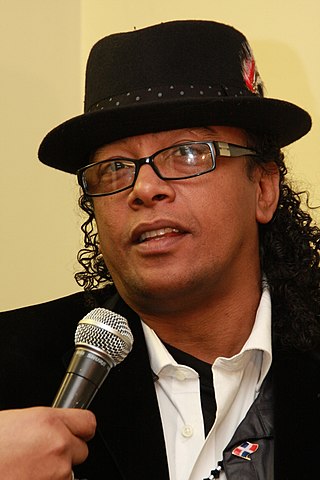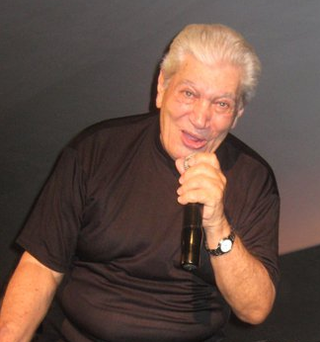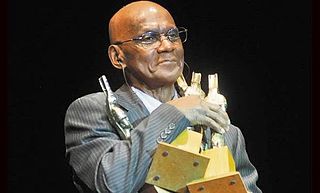Related Research Articles

Fania Records is a New York–based record label founded by Dominican-born composer and bandleader Johnny Pacheco and his American lawyer Jerry Masucci in 1964. The label took its name from a popular luncheonette frequented by musicians in Havana, Cuba that Masucci frequented when he worked for a public relations firm there during the pre-Castro era. Fania is known for its promotion of salsa music.
Marvin Santiago was a Puerto Rican salsa singer who became famous all across Latin America during the 1970s. He was also a part-time comedian on Puerto Rican television.

Ismael Rivera a.k.a. "Maelo", was a Puerto Rican composer and salsa singer.
A descarga is an improvised jam session consisting of variations on Cuban music themes, primarily son montuno, but also guajira, bolero, guaracha and rumba. The genre is strongly influenced by jazz and it was developed in Havana during the 1950s. Important figures in the emergence of the genre were Cachao, Julio Gutiérrez, Bebo Valdés, Peruchín and Niño Rivera in Cuba, and Tito Puente, Machito and Mario Bauzá in New York. Originally, descargas were promoted by record companies such as Panart, Maype and Gema under the label Cuban jam sessions. From the 1960s, the descarga format was usually adapted by large salsa ensembles, most notably the Fania All-Stars.
The Fania All-Stars is a musical group formed in 1968 as a showcase for the musicians on Fania Records, the leading salsa music record label of the time.

Juan Pablo Knipping Pacheco, known as Johnny Pacheco, was a Dominican musician, arranger, composer, bandleader, and record producer. Born in the Dominican Republic, Pacheco became a leading figure in the New York salsa scene in the 1960s and 1970s as the founder and musical director of Fania Records.
José Alberto Justiniano, better known by his stage name José Alberto "El Canario", is a salsa singer from the Dominican Republic. José Alberto moved to Puerto Rico with his family at the age of seven, and inspired by his rich Dominican culture went on to polish his singing at Las Antillas Military Academy. He relocated to New York in the early 1970s and sang with several orchestras. He received international attention as the singer of Típica 73 in October 1977.

Sergio Pascual Vargas Parra is a performer of merengue and bolero, who was very popular in the 80s and 90s, during the "Golden Age of Merengue" and today remains active as one of the leading figures in Dominican merengue. His brothers, Kaki and Johnny, are also performers of the genre and have been by his side for much of their respective musical careers.
RMM Records, also known as RMM Records & Video Corp, was an independent Latin music record label established in 1987 and based in New York City. The label was most active during the late 1980s and early 1990s and produced primarily salsa, Latin jazz, and merengue music. At its peak, RMM Records employed 55 staff members and had distribution deals in 42 cities around the world, occupying 9,000 square feet in two floors at its Soho headquarters. The label was established by Fania Records promoter Ralph Mercado, who had established RMM Management in 1972 as an artist management and booking agency, providing bookings for Latin artists Tito Puente, Celia Cruz, and Ray Barretto.
Raulín Rosendo is a Dominican salsa singer.
Ramón Orlando Valoy García, is a Dominican musician, singer, arranger, composer, record producer and songwriter, besides being a gran maestro pianist in Caribbean rhythms. Ramón Orlando received seven Casandra awards in the 1992 ceremony, including the Soberano, which is the most important category in the Dominican awards ceremony. In 2005, he was nominated for the Latin Grammy Award in the Best Merengue Album category.

Adalberto Santiago is an internationally known salsa singer.
Tempo Latino is a festival of salsa music and Latin music in Vic-Fezensac, France.

Cuco Valoy is a Dominican Republic singer, songwriter, percussionist and guitarist, who is versatile in salsa, son montuno, guaracha and merengue. He began performing with his brother Martín, under the name Los Ahijados. Valoy is the father of Ramón Orlando, with whom he formed the band Los Virtuosos, later changed to La Tribu. He is widely known for the song "Juliana", which was covered by the group DLG; a cover that featured Valoy's vocals.

José Peña Suazo, is a Dominican Merengue singer, arranger, composer and musician. Pena Suazo has played the trumpet, composed and arranged in many Dominican merengue music groups like Cuco Valoy's orchestra and La Artillería. He is currently the lead singer of La Banda Gorda.
Ramón Quián, better known as Monguito "El Único", was a Cuban vocalist, bandleader, producer and composer. An Afro-Cuban sonero, he had a simple improvising style with a distinctive nasal voice.
Antonio Rodríguez Castillo better known as Sexappeal is a Dominican Salsa singer from Santo Domingo. In 2005, he was awarded ''Best Dominican Salsa Singer of the Year'' in the Casandra awards, the most important in the country.
This article includes an overview of the major events and trends in Latin music in the 1980s, namely in Ibero-America. This includes recordings, festivals, award ceremonies, births and deaths of Latin music artists, and the rise and fall of various subgenres in Latin music from 1980 to 1989.
References
- ↑ "Fania All-Stars". Billboard . Archived from the original on 14 October 2015. Retrieved 25 August 2015.
- ↑ César Miguel Rondón The Book of Salsa: A Chronicle of Urban Music from the Caribbean 2008 - Page 42
- ↑ Ramón Orlando biography, Retrieved March 6, 2009
- ↑ Rodríguez, Nelson (2004, October). Latin beat music update. Latin Beat Magazine, Retrieved February 2, 2009
- ↑ Polin, Bruce (2006, February 22). Descarga.com recent DVDs, Retrieved February 4, 2009, from Descarga.com Web site: http://mail.descarga.com/pipermail/descarga-announce/2006/000135.html Archived 2009-02-16 at the Wayback Machine
- 1 2 Music of Puerto Rico Archived 2012-02-22 at the Wayback Machine Retrieved February 9, 2009
- ↑ Johnny Pacheco biography, Retrieved February 9, 2009, from JohnnyPacheco.com
- 1 2 The official website of José Alberto "El Canario" Retrieved February 6, 2009
- ↑ Michel “El buenón” cuenta su verdadera historia Archived October 25, 2010, at the Wayback Machine Retrieved February 25, 2009
- ↑ Nova, J. (2008). El sabor de la salsa dominicana. Retrieved February 28, 2009, from Salsa en Rosario Web site: "El sabor de la salsa dominicana - Noticias de Salsa, mundo tropical". Archived from the original on 2010-01-19. Retrieved 2009-11-29. (spanish)
- ↑ Biografia de mickey taveras, Retrieved February 25, 2009, from Retrieved March 4, 2009, from Univision.com Web site (spanish)
- ↑ Hernandez, D. P. (1995). Bachata: a social history of dominican popular music. Temple University Press.